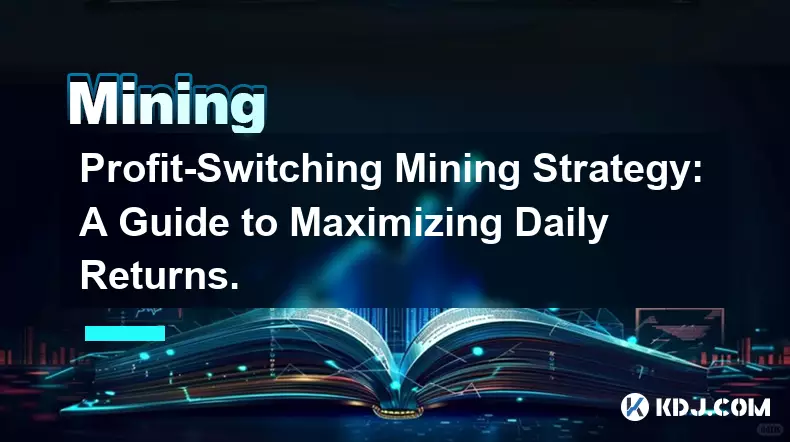-
 bitcoin
bitcoin $101752.865364 USD
-1.09% -
 ethereum
ethereum $3382.985899 USD
-1.38% -
 tether
tether $0.999658 USD
0.04% -
 xrp
xrp $2.272505 USD
-1.51% -
 bnb
bnb $989.089004 USD
0.14% -
 solana
solana $156.962612 USD
-3.08% -
 usd-coin
usd-coin $0.999776 USD
0.01% -
 tron
tron $0.290786 USD
-0.69% -
 dogecoin
dogecoin $0.174594 USD
-2.86% -
 cardano
cardano $0.560085 USD
-3.55% -
 hyperliquid
hyperliquid $40.023704 USD
-5.75% -
 chainlink
chainlink $15.324649 USD
-2.78% -
 bitcoin-cash
bitcoin-cash $493.576540 USD
-3.52% -
 zcash
zcash $571.320038 USD
-12.05% -
 stellar
stellar $0.280066 USD
-4.26%
Profit-Switching Mining Strategy: A Guide to Maximizing Daily Returns.
Profit-switching maximizes crypto mining profits by automatically redirecting hash power to the most profitable coins in real time, adapting to market changes instantly.
Nov 03, 2025 at 11:55 am

Understanding Profit-Switching in Cryptocurrency Mining
1. Profit-switching is a dynamic mining strategy that automatically redirects computational power to the most profitable cryptocurrency at any given moment. Instead of sticking to a single coin, miners use algorithms that analyze real-time market data, difficulty levels, and block rewards across multiple blockchains. This ensures optimal allocation of hash rate based on current profitability metrics.
2. Modern mining pools and software platforms integrate profit-switching engines that assess hundreds of altcoins every few seconds. These systems calculate estimated earnings per megahash and instantly shift mining operations toward the coin offering the highest return. The entire process happens without manual intervention, making it ideal for both small-scale and industrial mining setups.
3. The foundation of this strategy lies in the volatility of cryptocurrency markets. Coins like Ravencoin, Ergo, or Kaspa may surge in value or experience temporary drops in network difficulty, creating short-term arbitrage opportunities. Miners leveraging profit-switching can capitalize on these fluctuations before the broader market reacts.
4. Unlike traditional mining methods where loyalty to a specific blockchain is common, profit-switching prioritizes financial efficiency over ideological alignment. This approach treats hashing power as a fungible resource—similar to cloud computing capacity—that should be deployed wherever it generates the most revenue.
5. The core advantage of profit-switching is its ability to adapt rapidly to changing network conditions, ensuring miners extract maximum value from their hardware investments on a daily basis.
Key Tools and Platforms Enabling Automated Profit-Switching
1. Popular mining orchestrators such as NiceHash, Minerstat, and HashRat provide built-in profit-switching modules. These tools connect directly to miners’ rigs and continuously benchmark performance against global pricing feeds. They support multi-algorithm switching, allowing GPUs and ASICs to pivot between Scrypt, Ethash, KawPow, and other hashing protocols seamlessly.
2. APIs from exchanges like Binance and Kraken are integrated into these platforms to pull live price data. Combined with up-to-date information on network difficulty from blockchain explorers, the system computes net profitability after factoring in electricity costs, pool fees, and exchange rates.
3. Some advanced setups use custom scripts written in Python or Node.js to override default behaviors of mining software. These allow fine-tuned control over thresholds, minimum payout durations, and preferred coin lists, reducing exposure to highly volatile or illiquid tokens.
4. Cloud-based dashboards enable remote monitoring of switching events, historical earnings by coin, and uptime statistics. Alerts can be configured for sudden drops in profitability or hardware failures, ensuring continuous operation even when miners are not physically present.
5. By relying on intelligent automation rather than guesswork, these tools eliminate emotional decision-making and maintain consistent income streams regardless of individual coin trends.
Optimizing Hardware Utilization Through Algorithm Rotation
1. Different cryptocurrencies rely on distinct proof-of-work algorithms, each favoring certain types of hardware. For example, Ethereum Classic benefits from high-memory GPUs, while Litecoin mining favors ASICs designed for Scrypt. Profit-switching software evaluates which algorithm aligns best with available equipment at any moment.
2. A rig equipped with AMD RX 6800 XT cards might alternate between mining BeamHash, Cuckaroo29, and Octopus during a 24-hour period. Each switch is triggered by subtle changes in hashrate competition and token valuation, often invisible to human observation but detectable through machine analysis.
3. Energy efficiency plays a critical role in determining effective profitability. Even if a coin appears lucrative on paper, excessive power draw can erode margins. Advanced profit-switching configurations include wattage tracking and cost-per-kWh inputs to filter out unprofitable options.
4. Overclocking profiles are sometimes adjusted dynamically alongside algorithm changes. When transitioning from one protocol to another, voltage and core clock settings are modified to match optimal performance envelopes, preserving hardware longevity while maximizing output.
5. Efficient algorithm rotation ensures that no hashing cycle goes to waste, transforming otherwise idle or underperforming machines into consistently productive assets.
Frequently Asked Questions
How does profit-switching handle low-liquidity coins?Platforms typically apply liquidity filters that exclude coins with insufficient trading volume or no direct exchange listing. Even if a coin shows high theoretical returns, it won’t be mined unless it meets predefined safety criteria, preventing accumulation of unsellable assets.
Can profit-switching work with ASIC miners?Yes, though ASIC compatibility is limited to specific algorithms like SHA-256 or Scrypt. ASICs lack the flexibility of GPUs, so switching occurs only within supported families. However, services like NiceHash allow SHA-256 ASICs to rent out hashing power to the highest bidder, achieving a similar outcome.
Is there a risk of missing long-term gains by chasing short-term profits?That depends on investment philosophy. Profit-switching focuses purely on immediate returns and does not account for potential future appreciation of a particular coin. Miners seeking portfolio growth in specific tokens may choose to disable switching for selected periods.
What happens during sudden market crashes?During extreme volatility, some profit-switching engines may temporarily lock onto stablecoins backed by proof-of-work or pause operations altogether. Others continue rotating but adjust risk parameters to avoid mining coins experiencing panic selling or network instability.
Disclaimer:info@kdj.com
The information provided is not trading advice. kdj.com does not assume any responsibility for any investments made based on the information provided in this article. Cryptocurrencies are highly volatile and it is highly recommended that you invest with caution after thorough research!
If you believe that the content used on this website infringes your copyright, please contact us immediately (info@kdj.com) and we will delete it promptly.
- Ripple (XRP) in 2026: Hold or Fold? A Look at XRP's Future and Emerging DeFi Alternatives
- 2025-11-08 18:35:01
- Zcash ZEC Coin Price Explosion: From Privacy Niche to Center Stage
- 2025-11-08 18:55:01
- Berachain Price Prediction: Navigating the Honeycomb Hype in Crypto
- 2025-11-08 18:55:01
- Arthur Hayes, Gold, and Bitcoin: A Modern Monetary Trinity?
- 2025-11-08 19:15:01
- Shiba Inu's Next Move: Navigating a Shifting Market
- 2025-11-08 19:20:01
- Pakistan's Crypto Crossroads: Balancing Opportunity with Asset-Backed Realities
- 2025-11-08 19:20:01
Related knowledge

What is the block reward in mining?
Nov 06,2025 at 12:35am
Understanding Block Rewards in Cryptocurrency Mining1. The block reward is the incentive miners receive for successfully validating and adding a new b...

How do mining algorithms work?
Nov 06,2025 at 04:59am
Mining Algorithms and Their Role in Blockchain Networks1. Mining algorithms serve as the backbone of blockchain consensus mechanisms, ensuring that tr...

What is NiceHash mining?
Nov 06,2025 at 07:40am
NiceHash mining refers to the process of renting out computational power to individuals or organizations seeking to mine cryptocurrencies without owni...

Does an antivirus program affect mining?
Nov 05,2025 at 09:29pm
Understanding Decentralized Exchanges in the Crypto Ecosystem1. Decentralized exchanges (DEXs) operate without a central authority, allowing users to ...

What is the history of Bitcoin mining?
Nov 05,2025 at 08:15pm
Within the fast-moving world of cryptocurrency, new developments emerge daily, reshaping how investors, developers, and institutions interact with dig...

How is the energy consumption of mining justified?
Nov 05,2025 at 10:20pm
Energy Consumption in Cryptocurrency Mining1. The energy consumption associated with cryptocurrency mining has drawn significant attention from enviro...

What is the block reward in mining?
Nov 06,2025 at 12:35am
Understanding Block Rewards in Cryptocurrency Mining1. The block reward is the incentive miners receive for successfully validating and adding a new b...

How do mining algorithms work?
Nov 06,2025 at 04:59am
Mining Algorithms and Their Role in Blockchain Networks1. Mining algorithms serve as the backbone of blockchain consensus mechanisms, ensuring that tr...

What is NiceHash mining?
Nov 06,2025 at 07:40am
NiceHash mining refers to the process of renting out computational power to individuals or organizations seeking to mine cryptocurrencies without owni...

Does an antivirus program affect mining?
Nov 05,2025 at 09:29pm
Understanding Decentralized Exchanges in the Crypto Ecosystem1. Decentralized exchanges (DEXs) operate without a central authority, allowing users to ...

What is the history of Bitcoin mining?
Nov 05,2025 at 08:15pm
Within the fast-moving world of cryptocurrency, new developments emerge daily, reshaping how investors, developers, and institutions interact with dig...

How is the energy consumption of mining justified?
Nov 05,2025 at 10:20pm
Energy Consumption in Cryptocurrency Mining1. The energy consumption associated with cryptocurrency mining has drawn significant attention from enviro...
See all articles





















![The Graph Price Prediction [GRT Crypto Price News Today] The Graph Price Prediction [GRT Crypto Price News Today]](/uploads/2025/11/07/cryptocurrencies-news/videos/690d4df44fe69_image_500_375.webp)




















































